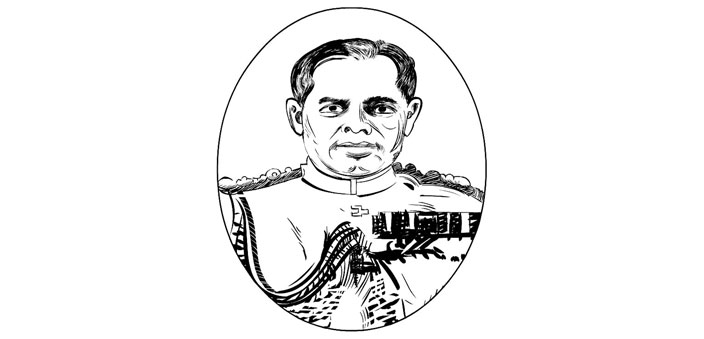An admirable officer (1914-2001)
A.K. Chatterji was born in Dhaka on 22 November 1914. He had his early education in Ravenshaw Collegiate School, Cuttack, and Brojo Mohan College, Barisal. He was awarded a scholarship for standing first in the Dhaka Division and passed his B.Sc. (Honours) in Physics from Presidency College, Calcutta. He again stood first in the Federal Public Service Commission examination in 1933, and was selected for the Royal Indian Marine. After training with the Royal Navy, he was commissioned on 1 September 1935. With four years service, he attended a course in anti-submarine warfare in the UK. His outstanding grasp of naval warfare and performance at the course was well-recognised, and he was appointed instructor at HMS Osprey (the Anti-Submarine Warfare School) in the UK. He was the only Indian officer to receive this honour. During 1941 to 1944, he served on various ships in the Atlantic Ocean. In 1944-45, he assumed command of the ship HMIS Kathiawar, a Fleet Mine-Sweeper, and participated in the Burma campaign.
In 1947, after attending the course at the Naval Staff College, UK, he was appointed as Director of Naval Plans and Intelligence at Naval HQ in the rank of Commander. The plan drawn up by him became a blueprint for the future of the Indian Navy. The Outline Plan for the Development and Reorganisation of the Royal Indian Navy was based on four roles: to safeguard Indian shipping, to ensure delivery of supplies, to prevent any landing by the enemy, and to support the Army in sea borne operations. It envisaged two fleets. Each fleet was to be built on a light fleet cruiser. It also included plans for naval aviation and submarines. It could not be implemented then due to limitation of budget allotment and reluctance of the Western powers to supply these weapons. UK authorities insisted that the Indian Navy was not mature enough to operate sophisticated weapons like submarines. They considered the Indian Navy to be a coastal defence force, with the Royal Navy to be responsible for oceanic and maritime defence.
He served as Naval Adviser to the High Commissioner for India in London from 1950 to 1953. His next assignment was as commanding officer of the cruiser INS Delhi. The young officers on board watched with mouths agape, his easy handling of the ship.
He attended a course for senior officers at the Imperial Defence College, and on return took over as the Deputy Chief of Naval Staff in February 1958, and was promoted to the rank of Rear Admiral in March 1959. The next assignment was as Flag Officer Commanding of the Indian Fleet, and he paid a visit to Thailand among other countries, which was the first visit of an India ship there. He was promoted to the rank of Vice-Admiral in January 1964, and took over the command of National Defence College. He took over the command of the Navy on 4 March 1966, and was promoted to the rank of Admiral on 1 March 1968, the first Navy Chief to hold that rank. It was one of the many firsts he had achieved in his career. As Chief, he set about to acquire ships and weapon systems required for a Blue Water Navy, the concept for which he had visualised as Director, Plans. The central aim of the Navy Plan for 1969-70 was self-reliance. He vigorously followed specific acquisition of ships. The missile boats inducted during his tenure were fondly called AK boats after his initials. These boats played a crucial role in the 1971 War in bombing Karachi.
He was a hard disciplinarian, and commanding officers tried to emulate him in later life. His personality is best described by his grandson, “He was a real extrovert. He got energy from being around people. His life was never focussed on himself.”
He retired on 28 February 1970, and passed away on 6 August 2001.

